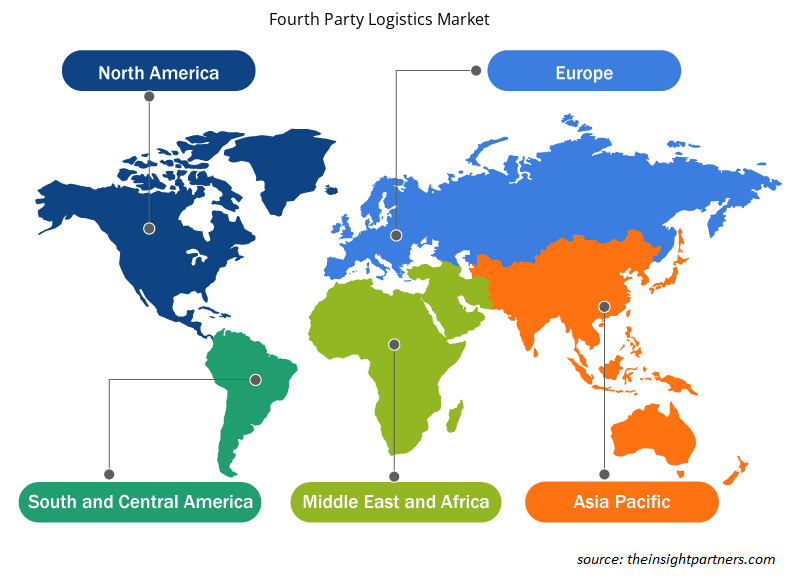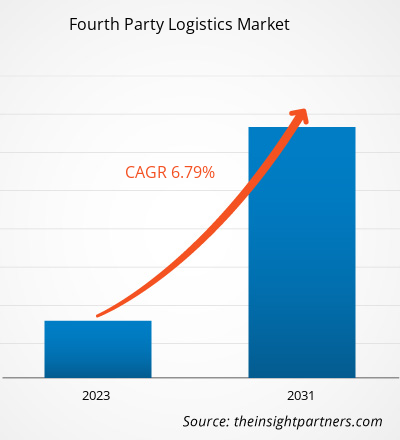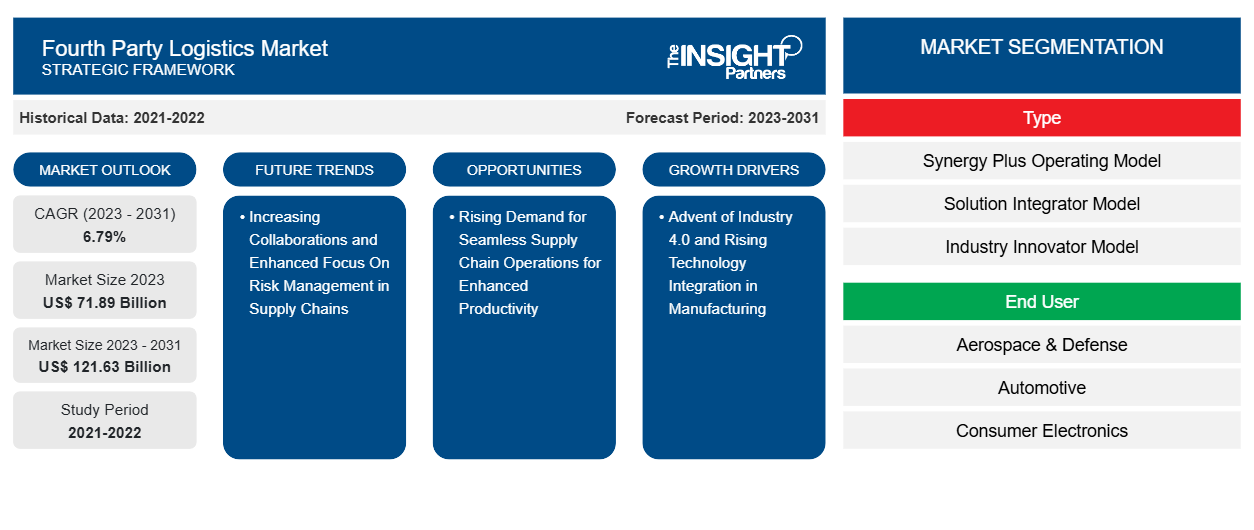第四方物流市场规模预计将从 2023 年的 718.9 亿美元增至 2031 年的 1216.3 亿美元。预计 2023-2031 年市场复合年增长率为 6.79%。
工业 4.0 的出现推动了制造业的数字化转型。各行各业都在利用这种先进的数字技术的力量,通过简化各种供应链流程,为客户公司提供竞争优势。
第四方物流市场分析
据观察,区域人口结构在 4PL 服务市场的增长中也发挥了至关重要的作用。例如,零售业观察到了 4PL 的采用,而电子商务的出现又推动了零售业的发展。由于亚太地区拥有世界三分之一以上的人口,因此该地区电子商务行业的市场吸引力非常高。此外,发展中经济体和个人可支配收入的增加进一步推动了电子商务行业的增长。
由于该地区人口结构多样化,需求多样化,导致供应链复杂化。这种复杂的供应链导致航运公司对部署 4PL 服务的需求不断增长。自上个十年以来,随着数字化技术的采用和进一步的技术改进,不同终端用户行业的需求显著加速。随着该市场的领先企业不断扩大其目标市场,通过扩大现有产品组合、多样化客户群以及开发新应用和市场,所有知名企业都面临着激烈的竞争。
第四方物流市场概况
将整个供应链功能外包给供应链管理领域知识更丰富的合作伙伴,可以降低最后一英里交付的复杂性。通过外包物流实现的一些无形利益包括节省成本、节省人力资本、不锁定营运资金以及更好地访问客户网络。
第四方物流概念的出现本质上是为了消除日益复杂的供应链环境中上述所有瓶颈。第四方物流 (4PL) 服务也称为供应链即服务,其中 4PL 提供商与客户公司的物流部门整合在一起。这使 4PL 服务提供商能够亲身参与供应链中涉及的整个运营,从订单管理到仓储和合规法规再到供应商管理。4PL 服务提供商将充当众多供应链提供商和客户组织之间的唯一接口链接。借助这一点,4PL 提供商可以使用先进的资源管理所有运营,以优化并为客户提供价值。
定制此报告以满足您的需求
您可以免费定制任何报告,包括本报告的部分内容、国家级分析、Excel 数据包,以及为初创企业和大学提供优惠和折扣
-
获取此报告的关键市场趋势。这个免费样品将包括数据分析,从市场趋势到估计和预测。
第四方物流市场驱动因素和机遇
工业 4.0 的到来和制造业技术整合的不断提升
第四方物流服务提供商可以有效利用先进软件、云计算和大数据等新兴数字技术,保持整个供应链的可见性,从而提高可见性、透明度、运营和生产力。此外,随着物联网 (IoT)、自动化和机器人等技术越来越受到重视,预计组织对第四方物流部署的需求将迅速增加。
为提高生产力,对无缝供应链运营的需求不断增长
在供应链中,活动部件有时会受到不可预见的情况的影响,例如自然灾害、地缘政治紧张局势、环境问题、与关税相关的复杂情况和法规以及合规性波动。此外,供应链的碎片化性质导致参与实体之间缺乏沟通和透明度。当前消费者的需求高度动态,即使消费者端的一点小不满也可能对公司的盈利产生重大影响。按需交付产品的迅速兴起促使当今的企业从传统的内部物流模式转向更先进、更具成本效益的外包或基于合同的物流模式。
第四方物流市场报告细分分析
有助于得出第四方物流市场分析的关键部分是类型和最终用户。
- 根据类型,市场分为协同加运营模式、解决方案集成商模式和行业创新者模式。解决方案集成商模式部分在 2023 年占据了更大的市场份额。
- 根据最终用户,市场细分为航空航天和国防、汽车、消费电子、食品和饮料、工业、医疗保健、零售等。零售业在 2023 年占据了最大的市场份额。
第四方物流市场地域分析
第四方物流市场报告的地理范围主要分为五个区域:北美、欧洲、亚太、中东和非洲、南美。
第四方物流市场报告的范围包括北美(美国、加拿大和墨西哥)、欧洲(西班牙、英国、德国、法国、意大利和欧洲其他地区)、亚太地区(韩国、中国、印度、日本、澳大利亚和亚太地区其他地区)、中东和非洲(南非、沙特阿拉伯、阿联酋和中东和非洲其他地区)以及南美洲和中美洲(巴西、阿根廷和南美洲和中美洲其他地区)。就收入而言,亚太地区在 2023 年占据了第四方物流市场份额的主导地位。欧洲是全球第四方物流市场的第二大贡献者,其次是北美。
北美经济繁荣的地区由美国和加拿大等高度发达的经济体组成。工业化一直是美国和加拿大发达经济体的重中之重,多年来也是推动经济发展的主要因素。据说美国拥有世界上技术最先进的汽车、医疗保健、航空航天和国防以及消费电子行业。大批量制造和与世界其他国家开展的联盟贸易使北美地区成为运输和物流服务的战略枢纽。由于经济发达,北美的公司在运输和物流活动上投入了大量预算,因此为第四方物流市场的发展做出了贡献。北美成熟的数字基础设施进一步凸显了物流供应服务领域的扩展。类型(协同效应加运营模式、解决方案集成商模式和行业创新者模式);最终用户(航空航天和国防、汽车、消费电子、食品和饮料、工业、医疗保健、零售等)
第四方物流市场区域洞察
Insight Partners 的分析师已详细解释了预测期内影响第四方物流市场的区域趋势和因素。本节还讨论了北美、欧洲、亚太地区、中东和非洲以及南美和中美洲的第四方物流市场细分和地理位置。

- 获取第四方物流市场的区域具体数据
第四方物流市场报告范围
| 报告属性 | 细节 |
|---|---|
| 2023 年的市场规模 | 718.9亿美元 |
| 2031 年市场规模 | 1216.3亿美元 |
| 全球复合年增长率(2023 - 2031) | 6.79% |
| 史料 | 2021-2022 |
| 预测期 | 2023-2031 |
| 涵盖的领域 |
按类型
|
| 覆盖地区和国家 |
北美
|
| 市场领导者和主要公司简介 |
|
第四方物流市场参与者密度:了解其对业务动态的影响
第四方物流市场正在快速增长,这得益于最终用户需求的不断增长,而这些需求又源于消费者偏好的不断变化、技术进步以及对产品优势的认识不断提高等因素。随着需求的增加,企业正在扩大其产品范围,进行创新以满足消费者的需求,并利用新兴趋势,从而进一步推动市场增长。
市场参与者密度是指在特定市场或行业内运营的企业或公司的分布情况。它表明在给定市场空间中,相对于其规模或总市场价值,有多少竞争对手(市场参与者)存在。
在第四方物流市场运营的主要公司有:
- 艾琳国际服务
- 公司
- 联合包裹服务公司
- 公司
- 捷富凯集团
免责声明:上面列出的公司没有按照任何特定顺序排列。

- 了解第四方物流市场顶级关键参与者概况
第四方物流市场新闻和最新发展
第四方物流市场通过收集一手和二手研究后的定性和定量数据进行评估,其中包括重要的公司出版物、协会数据和数据库。以下是第四方物流市场的发展和战略列表:
- 2023 年 12 月,北美领先的零担货运运输提供商 XPO (NYSE: XPO) 宣布,美国特拉华州破产法院已批准该公司收购 Yellow Corporation 之前运营的 28 个服务中心的提议。XPO 将购买 26 个服务中心并承担另外两个地点的现有租约。该交易预计将于 2023 年底完成。(来源:XPO,新闻稿/公司网站/通讯)
第四方物流市场报告范围和交付成果
“第四方物流市场规模和预测(2021-2031)”报告对以下领域进行了详细的市场分析:
- 范围内所有主要细分市场的全球、区域和国家层面的市场规模和预测
- 市场动态,如驱动因素、限制因素和关键机遇
- 未来的主要趋势
- 详细的波特五力分析
- 全球和区域市场分析涵盖关键市场趋势、主要参与者、法规和最新市场发展
- 行业格局和竞争分析,涵盖市场集中度、热点图分析、知名参与者和最新发展
- 带有 SWOT 分析的详细公司简介
- 历史分析(2 年)、基准年、预测(7 年)及复合年增长率
- PEST和SWOT分析
- 市场规模、价值/数量 - 全球、区域、国家
- 行业和竞争格局
- Excel 数据集
近期报告
相关报告
客户评价
购买理由
- 明智的决策
- 了解市场动态
- 竞争分析
- 客户洞察
- 市场预测
- 风险规避
- 战略规划
- 投资论证
- 识别新兴市场
- 优化营销策略
- 提升运营效率
- 顺应监管趋势























 获取免费样品 - 第四方物流市场
获取免费样品 - 第四方物流市场